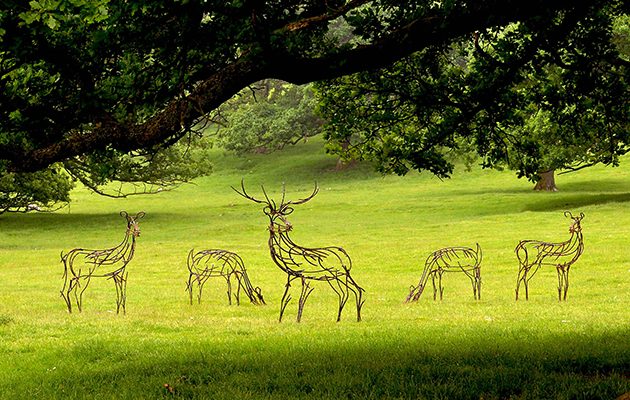While Andrew Kay’s sculptures are striking, their relationship to the landscape produces a second work of art, as he explains to Janet Menzies
Andrew Kay uses the scenery that surrounds him as his canvas. His striking steel sculptures act as one work of art, while their relationship to the landscape creates a second, as he explains to Janet Menzies.
For more sporting artists, it is time that we re-evaluate the work of Raoul Millais. And the much-larger-than-life bronze lion sculpture by Bruce Little is now safely installed at Longleat, after a torturous journey from South Africa.
ANDREW KAY
Ever since Hamlet instructed his players to “hold, as ’twere, the mirror up to nature”, artists in all fields have tried to achieve this ideal. Cumbrian wildlife sculptor Andrew Kay goes a step further, making nature itself the mirror for his work. His canvas is the sky, a hillside or even a full moon, against which he sketches with strip steel.

Heron by lake. The sculptures are made from mild steel.
Though his sculptures are permanent and three-dimensional, their impact is of something fleeting or glimpsed, often ephemeral, as with his two hares boxing in front of the full moon. Kay explains: “I had finished the hares and just had them stored by the barn and I noticed the moon, so I went out and managed to get a photograph of the hares boxing silhouetted by the full moon.”
Even if Kay didn’t move the hares from the barn to their intended site, it is an image that could only ever be recreated a few times a year. So Kay has essentially created two works: the sculpture itself and the photograph of the sculpture.

Rutting stags. Kay says the steel is light and malleable to work with.
It would be easy to obsess over the question of whether the landscape defines the sculpture or whether the sculpture provides a punctuation on the landscape, but Kay insists: “I am spontaneous about the work. I don’t want to sound pretentious but, yes, they do want to be seen in the context of the landscape. I want you to see the silhouette of the form of the sculpture. And so the backdrop of the landscape delineates the work itself. I try to be immediate when it comes to making the sculptures – just to suggest the feeling of a flexed hock or the bend of the neck. I am focusing on getting life in the sculpture. When I am doing a deer I want to capture that he is looking up and he’s watching you and grazing at the same time. I want to catch the essence of that moment of his watchfulness.
“I like the spontaneity of working in metal. It is very quick. You can sketch with it in a way – the way you bend the metal is like making a charcoal or a pencil sketch on paper. The material is so light and malleable it is great fun to work and you can remodel it. I use mild steel mainly. It is quite soft to work with and yet it has permanence.”
SURROUNDED BY SCENERY
Despite having a degree in design, Kay was always going to end up back home near Kirkby Lonsdale making sculptures. “Even as a child I used to be whittling a stick or something,” he remembers. “I am so lucky to live in the middle of nowhere surrounded by all this scenery, so that my inspiration is all around me – you can see nature just by looking out of the bathroom window. When we close down the workshop in the evening
everything quietens down and that’s when the wildlife comes out and makes itself known.”

Shire on Ash Hill. Kay’s sculptures each consist of about 80 steel pieces.
Kay now employs six people and is building a new workshop to meet all his commissions. “We are up a little lane and the steel gets delivered to us from Carlisle in six-metre lengths. We cut it into pieces – there are around 80 pieces in each work – and then we start welding together to form the sculpture by eye. I have an idea for an animal and then you can form the bare bones quite quickly. The material is inexpensive and quite easy to work but it has to be exactly right. Go 10mm out and you lose the essence of the form and the movement and the whole thing becomes just a piece of steel.”
Kay’s work can be seen all over the world. “We have two deer in Singapore, in the centre of the city, and they look like they could be there naturally. A lady in Mauritius recently sent me photographs of my deer with the Indian Ocean in the background and, again, it worked.” But Kay confesses: “Times were lean when we were getting started and then, about 15 years ago, my wife suggested an advert in The Daily Telegraph, which we couldn’t really afford but 14 commissions came in from that and we have been inundated with work ever since. People love the photographs of the pieces that they see in magazines or on my website and I enjoy the photography aspect.”

Swales, by Andrew Kay.
Viewing Kay’s sculptures “in the wild”, as it were, is a little more difficult. “I recently exhibited in Notting Hill but with the nature of my work I don’t often have collective exhibitions. The big plan for the next couple of years is to create a sculpture park here in Cumbria – my dream is to have an amphitheatre as well.” In the meantime, Kay is happy to welcome visitors and give tips for those who want to track down his work in its natural habitat.
Start your Andrew Kay sculpture safari by visiting his website www.andrewkaysculpture.co.uk and then send him an email for details of works nearby.





